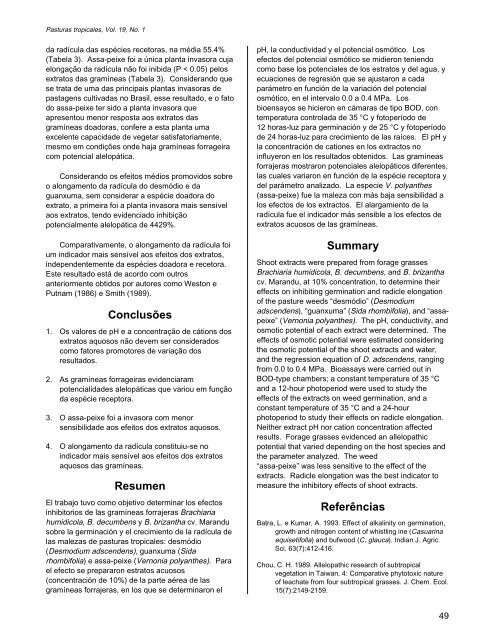Inibição da germinação e alongamento da radícula de invasoras de ...
Inibição da germinação e alongamento da radícula de invasoras de ...
Inibição da germinação e alongamento da radícula de invasoras de ...
You also want an ePaper? Increase the reach of your titles
YUMPU automatically turns print PDFs into web optimized ePapers that Google loves.
Pasturas tropicales, Vol. 19, No. 1<br />
<strong>da</strong> <strong>radícula</strong> <strong>da</strong>s espécies recetoras, na média 55.4%<br />
(Tabela 3). Assa-peixe foi a única planta invasora cuja<br />
elongação <strong>da</strong> <strong>radícula</strong> não foi inibi<strong>da</strong> (P < 0.05) pelos<br />
extratos <strong>da</strong>s gramíneas (Tabela 3). Consi<strong>de</strong>rando que<br />
se trata <strong>de</strong> uma <strong>da</strong>s principais plantas <strong>invasoras</strong> <strong>de</strong><br />
pastagens cultiva<strong>da</strong>s no Brasil, esse resultado, e o fato<br />
do assa-peixe ter sido a planta invasora que<br />
apresentou menor resposta aos extratos <strong>da</strong>s<br />
gramíneas doadoras, confere a esta planta uma<br />
excelente capaci<strong>da</strong><strong>de</strong> <strong>de</strong> vegetar satisfatoriamente,<br />
mesmo em condições on<strong>de</strong> haja gramíneas forrageira<br />
com potencial alelopática.<br />
Consi<strong>de</strong>rando os efeitos médios promovidos sobre<br />
o <strong>alongamento</strong> <strong>da</strong> <strong>radícula</strong> do <strong>de</strong>smódio e <strong>da</strong><br />
guanxuma, sem consi<strong>de</strong>rar a espécie doadora do<br />
extrato, a primeira foi a planta invasora mais sensível<br />
aos extratos, tendo evi<strong>de</strong>nciado inhibição<br />
potencialmente alelopática <strong>de</strong> 4429%.<br />
Comparativamente, o <strong>alongamento</strong> <strong>da</strong> <strong>radícula</strong> foi<br />
um indicador mais sensível aos efeitos dos extratos,<br />
in<strong>de</strong>pen<strong>de</strong>ntemente <strong>da</strong> espécies doadora e recetora.<br />
Este resultado está <strong>de</strong> acordo com outros<br />
anteriormente obtidos por autores como Weston e<br />
Putnam (1986) e Smith (1989).<br />
Conclusões<br />
1. Os valores <strong>de</strong> pH e a concentração <strong>de</strong> cátions dos<br />
extratos aquosos não <strong>de</strong>vem ser consi<strong>de</strong>rados<br />
como fatores promotores <strong>de</strong> variação dos<br />
resultados.<br />
2. As gramíneas forrageiras evi<strong>de</strong>nciaram<br />
potenciali<strong>da</strong><strong>de</strong>s alelopáticas que variou em função<br />
<strong>da</strong> espécie receptora.<br />
3. O assa-peixe foi a invasora com menor<br />
sensibili<strong>da</strong><strong>de</strong> aos efeitos dos extratos aquosos.<br />
4. O <strong>alongamento</strong> <strong>da</strong> <strong>radícula</strong> constituiu-se no<br />
indicador mais sensível aos efeitos dos extratos<br />
aquosos <strong>da</strong>s gramíneas.<br />
Resumen<br />
El trabajo tuvo como objetivo <strong>de</strong>terminar los efectos<br />
inhibitorios <strong>de</strong> las gramíneas forrajeras Brachiaria<br />
humidicola, B. <strong>de</strong>cumbens y B. brizantha cv. Marandu<br />
sobre la germinación y el crecimiento <strong>de</strong> la <strong>radícula</strong> <strong>de</strong><br />
las malezas <strong>de</strong> pasturas tropicales: <strong>de</strong>smódio<br />
(Desmodium adscen<strong>de</strong>ns), guanxuma (Si<strong>da</strong><br />
rhombifolia) e assa-peixe (Vernonia polyanthes). Para<br />
el efecto se prepararon estratos acuosos<br />
(concentración <strong>de</strong> 10%) <strong>de</strong> la parte aérea <strong>de</strong> las<br />
gramíneas forrajeras, en los que se <strong>de</strong>terminaron el<br />
pH, la conductivi<strong>da</strong>d y el potencial osmótico. Los<br />
efectos <strong>de</strong>l potencial osmótico se midieron teniendo<br />
como base los potenciales <strong>de</strong> los estratos y <strong>de</strong>l agua, y<br />
ecuaciones <strong>de</strong> regresión que se ajustaron a ca<strong>da</strong><br />
parámetro en función <strong>de</strong> la variación <strong>de</strong>l potencial<br />
osmótico, en el intervalo 0.0 a 0.4 MPa. Los<br />
bioensayos se hicieron en cámaras <strong>de</strong> tipo BOD, con<br />
temperatura controla<strong>da</strong> <strong>de</strong> 35 °C y fotoperíodo <strong>de</strong><br />
12 horas-luz para germinación y <strong>de</strong> 25 °C y fotoperíodo<br />
<strong>de</strong> 24 horas-luz para crecimiento <strong>de</strong> las raíces. El pH y<br />
la concentración <strong>de</strong> cationes en los extractos no<br />
influyeron en los resultados obtenidos. Las gramíneas<br />
forrajeras mostraron potenciales alelopáticos diferentes,<br />
las cuales variaron en función <strong>de</strong> la espécie receptora y<br />
<strong>de</strong>l parámetro analizado. La especie V. polyanthes<br />
(assa-peixe) fue la maleza con más baja sensibili<strong>da</strong>d a<br />
los efectos <strong>de</strong> los extractos. El alargamiento <strong>de</strong> la<br />
<strong>radícula</strong> fue el indicador más sensible a los efectos <strong>de</strong><br />
extratos acuosos <strong>de</strong> las gramíneas.<br />
Summary<br />
Shoot extracts were prepared from forage grasses<br />
Brachiaria humidicola, B. <strong>de</strong>cumbens, and B. brizantha<br />
cv. Marandu, at 10% concentration, to <strong>de</strong>termine their<br />
effects on inhibiting germination and radicle elongation<br />
of the pasture weeds “<strong>de</strong>smódio” (Desmodium<br />
adscen<strong>de</strong>ns), “guanxuma” (Si<strong>da</strong> rhombifolia), and “assapeixe”<br />
(Vernonia polyanthes). The pH, conductivity, and<br />
osmotic potential of each extract were <strong>de</strong>termined. The<br />
effects of osmotic potential were estimated consi<strong>de</strong>ring<br />
the osmotic potential of the shoot extracts and water,<br />
and the regression equation of D. adscen<strong>de</strong>ns, ranging<br />
from 0.0 to 0.4 MPa. Bioassays were carried out in<br />
BOD-type chambers; a constant temperature of 35 °C<br />
and a 12-hour photoperiod were used to study the<br />
effects of the extracts on weed germination, and a<br />
constant temperature of 35 °C and a 24-hour<br />
photoperiod to study their effects on radicle elongation.<br />
Neither extract pH nor cation concentration affected<br />
results. Forage grasses evi<strong>de</strong>nced an allelopathic<br />
potential that varied <strong>de</strong>pending on the host species and<br />
the parameter analyzed. The weed<br />
“assa-peixe” was less sensitive to the effect of the<br />
extracts. Radicle elongation was the best indicator to<br />
measure the inhibitory effects of shoot extracts.<br />
Referências<br />
Batra, L. e Kumar, A. 1993. Effect of alkalinity on germination,<br />
growth and nitrogen content of whistling ine (Casuarina<br />
equisetifolla) and bufwood (C. glauca). Indian J. Agric.<br />
Sci. 63(7):412-416.<br />
Chou, C. H. 1989. Allelopathic research of subtropical<br />
vegetation in Taiwan. 4: Comparative phytotoxic nature<br />
of leachate from four subtropical grasses. J. Chem. Ecol.<br />
15(7):2149-2159.<br />
49

















